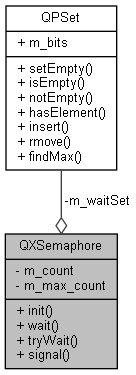Counting Semaphore of the QXK preemptive kernel.
More...
#include <qxthread.hpp>
Counting Semaphore of the QXK preemptive kernel.
- Description
- QP::QXSemaphore is a blocking mechanism intended primarily for signaling extended threads. The semaphore is initialized with the maximum count (see QP::QXSemaphore::init()), which allows you to create a binary semaphore (when the maximum count is 1) and counting semaphore when the maximum count is > 1.
- Usage
- The following example illustrates how to instantiate and use the semaphore in your application.
QXSemaphore BTN_sema;
int main() {
. . .
BTN_sema.init(0U,
1U);
. . .
}
void main_threadXYZ(QXThread * const me) {
while (1) {
. . .
. . .
}
}
void GPIO_Handler(void) {
. . .
BTN_sema.signal();
. . .
}
static constexpr std::uint_fast16_t QXTHREAD_NO_TIMEOUT
no-timeout sepcification when blocking on queues or semaphores
Definition at line 153 of file qxthread.hpp.
◆ init()
initialize the counting semaphore
- Description
- Initializes a semaphore with the specified count and maximum count. If the semaphore is used for resource sharing, both the initial count and maximum count should be set to the number of identical resources guarded by the semaphore. If the semaphore is used as a signaling mechanism, the initial count should set to 0 and maximum count to 1 (binary semaphore).
- Parameters
-
| [in] | count | initial value of the semaphore counter |
| [in] | max_count | maximum value of the semaphore counter. The purpose of the max_count is to limit the counter so that the semaphore cannot unblock more times than the maximum. |
- Note
- QXSemaphore::init() must be called before the semaphore can be used (signaled or waited on).
- Precondition
- max_count must be greater than zero
Definition at line 77 of file qxk_sema.cpp.
◆ wait()
wait (block) on the semaphore
- Description
- When an extended thread calls QXSemaphore::wait() and the value of the semaphore counter is greater than 0, QXSemaphore_wait() decrements the semaphore counter and returns (true) to its caller. However, if the value of the semaphore counter is 0, the function places the calling thread in the waiting list for the semaphore. The thread waits until the semaphore is signaled by calling QXSemaphore::signal(), or the specified timeout expires. If the semaphore is signaled before the timeout expires, QXK resumes the highest-priority extended thread waiting for the semaphore.
- Parameters
-
| [in] | nTicks | number of clock ticks (at the associated rate) to wait for the semaphore. The value of QXTHREAD_NO_TIMEOUT indicates that no timeout will occur and the semaphore will wait indefinitely. |
- Returns
- true if the semaphore has been signaled, and false if the timeout occured.
- Note
- Multiple extended threads can wait for a given semahpre.
- Precondition
- this function must:
- NOT be called from an ISR;
- the semaphore must be initialized
- be called from an extended thread;
- the thread must NOT be already blocked on any object.
-
also: the thread must NOT be holding a scheduler lock.
Definition at line 109 of file qxk_sema.cpp.
◆ tryWait()
try wait on the semaphore (non-blocking)
- Description
- This operation checks if the semaphore counter is greater than 0, in which case the counter is decremented.
- Returns
- 'true' if the semaphore has count available and 'false' NOT available.
- Note
- This function can be called from any context, including ISRs and basic threds (active objects).
- Precondition
- the semaphore must be initialized
Definition at line 191 of file qxk_sema.cpp.
◆ signal()
signal (unblock) the semaphore
- Description
- If the semaphore counter value is 0 or more, it is incremented, and this function returns to its caller. If the extended threads are waiting for the semaphore to be signaled, QXSemaphore_signal() removes the highest- priority thread waiting for the semaphore from the waiting list and makes this thread ready-to-run. The QXK scheduler is then called to determine if the awakened thread is now the highest-priority thread that is ready-to-run.
- Returns
- 'true' when the semaphore gets signaled and 'false' when the semaphore count exceeded the maximum.
- Note
- A semaphore can be signaled from many places, including from ISRs, basic threads (AOs), and extended threads.
- Precondition
- the semaphore must be initialized
Definition at line 230 of file qxk_sema.cpp.
◆ m_waitSet
set of extended threads waiting on this semaphore
Definition at line 169 of file qxthread.hpp.
◆ m_count
◆ m_max_count
maximum value of the semaphore counter
Definition at line 171 of file qxthread.hpp.
The documentation for this class was generated from the following files:
